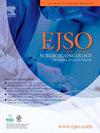G/GEJ-CSC和GAC的临床病理特征和生存差异:一项倾向评分匹配的大规模跨人群回顾性研究
IF 2.9
2区 医学
Q2 ONCOLOGY
引用次数: 0
摘要
背景和目的:胃鳞状细胞癌和腺鳞状细胞癌,统称为胃和胃食管交界处含鳞状细胞癌(G/GEJ-CSC)。由于发病率低,异质性高,其临床病理特征和预后模式缺乏系统的研究。传统观点认为更具侵略性,但缺乏大规模证据。本研究采用大规模队列比较G/GEJ-CSC与胃腺癌(GAC),明确其特征、预后,支持个性化治疗。方法:回顾性分析浙江省肿瘤医院(2010-2024)和SEER数据库(2004-2020)符合条件的G/GEJ-CSC和GAC患者的临床病理特征。倾向评分匹配用于平衡混杂因素。采用Kaplan-Meier法和Cox比例风险模型评价生存差异。结果:与GAC患者相比,G/GEJ-CSC多发于胃-食管交界处,Epstein-Barr病毒阳性率明显高于GAC患者,临床病理特征较GAC患者差。多因素Cox分析显示,病理类型是影响总生存的独立危险因素(中国队列:HR = 1.45,P = 0.044; SEER:HR = 1.23)。Kaplan-Meier生存分析显示,G/GEJ-CSC患者的5年OS明显低于GAC(中国队列:33.0% vs 56.1%)。结论:G/GEJ-CSC是一种罕见的胃癌亚型,具有独特的侵袭性生物学和“早期高危”预后。需要加强早期识别和个性化治疗探索。本文章由计算机程序翻译,如有差异,请以英文原文为准。
Clinicopathological features and survival differences between G/GEJ-CSC and GAC: A Propensity score-matched, large-scale cross-population retrospective study
Background and purpose
Gastric squamous cell carcinoma and adenosquamous carcinoma, collectively termed gastric and gastroesophageal junction carcinomas containing squamous cells (G/GEJ-CSC).Due to low incidence and high heterogeneity, their clinicopathological features and prognostic patterns lack systematic investigation. Traditional views suggest greater aggressiveness but lack large-scale evidence. This study uses large-scale cohorts to compare G/GEJ-CSC with gastric adenocarcinoma (GAC), clarifying features, prognosis, and supporting personalized treatment.
Methods
Retrospectively analyzed the clinicopathological features of eligible patients with G/GEJ-CSC and GAC from Zhejiang Cancer Hospital (2010–2024) and the SEER database (2004–2020). Propensity score matching was used to balance confounding factors. Kaplan-Meier method and Cox proportional hazards model were employed to evaluate survival differences.
Results
Compared with GAC patients, G/GEJ-CSC occurred more frequently in the gastric-esophageal junction and exhibited a significantly higher Epstein-Barr virus positivity rate, along with worse clinicopathological features. Multivariate Cox analysis showed that pathological type was an independent risk factor for overall survival (Chinese cohort:HR = 1.45,P = 0.044; SEER:HR = 1.23).Kaplan-Meier survival analysis revealed that OS was significantly inferior in G/GEJ-CSC patients compared with GAC (Chinese cohort: 5-year OS 33.0 % vs. 56.1 %, P < 0.001; SEER: 34.8 % vs. 42.7 %, P = 0.013), and this difference persisted after PSM adjustment (Chinese cohort: 5-year OS 36.4 % vs. 52.0 %, P = 0.034; SEER: 34.8 % vs. 44.1 %, P = 0.041). Stratified analysis further indicated a more pronounced survival gap in early-stage patients (Chinese cohort: 5-year OS43.1 % vs.84.1 %, P < 0.001; SEER: 45.4 % vs. 54.2 %, P = 0.002).
Conclusion
G/GEJ-CSC, a rare gastric cancer subtype, has unique aggressive biology and “early high-risk” prognosis. Need enhanced early identification and personalized treatment exploration.
求助全文
通过发布文献求助,成功后即可免费获取论文全文。
去求助
来源期刊

Ejso
医学-外科
CiteScore
6.40
自引率
2.60%
发文量
1148
审稿时长
41 days
期刊介绍:
JSO - European Journal of Surgical Oncology ("the Journal of Cancer Surgery") is the Official Journal of the European Society of Surgical Oncology and BASO ~ the Association for Cancer Surgery.
The EJSO aims to advance surgical oncology research and practice through the publication of original research articles, review articles, editorials, debates and correspondence.
 求助内容:
求助内容: 应助结果提醒方式:
应助结果提醒方式:


